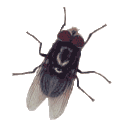
My research examines the effects of ivermectin in calliphorid and sarcophagid flies that breed in rat carrion in the field. Ivermectin is a semi-synthetic drug widely used for treatment of livestock parasites. Its a macrocyclic lactone produced by Streptomices avermetilis, is highly effective against ectoparasites e endoparasites of many domestic and wild animals (Campbell et al., 1983).
Rats (Rattus norvegicus) were injected subcutaneously with Ivomec at the recommended dosage of 0,2 mg kg-1 of ivermectin. Untreated rats were used as controls. 24 h after injection, the animals are killed by cervical dislocation and placed in the field. One sarcophagid and three calliphorids species emerging from carcasses: Pattonella intermutans, Lucilia eximia, Hemilucilia segmentaria and H. semidiaphana. P. intermutans and L. eximia were considered for statistic analysis.
The output of fly puparia from carcasses and number of emerging adults was higher in control group (p< 0,001). The length of developmental period no differs significantly between treatments, however, the dry weight of adults differed between sexes and treatments, was higher in treated flies (p< 0,001). Ivermectin residues in tissues of treated carcasses were physiologically significant to kill a large proportion of fly larvae. The larvae that feed in this tissues with ivermectin exhibits gradual loss of mobility, following paralysis and death. The increase of dry weight in treated flies probably results of reduced intensity of larval competition by killing part of the population.
Cited References: Campbell, W.C., Fisher, M.I., Stapley, E.O., Albers-Schonberg, G. & Jacobs, T.A. (1983). Ivermectin: a potent new antiparasitic agent. Science, 221, 823-828.
